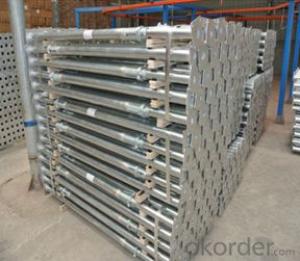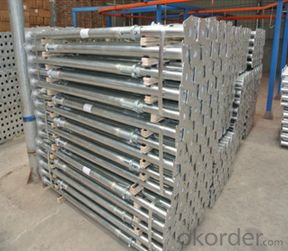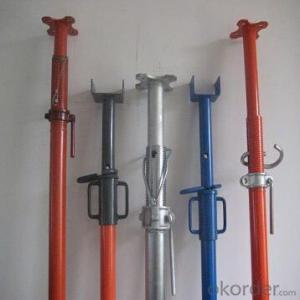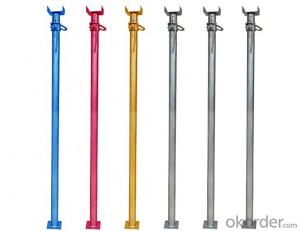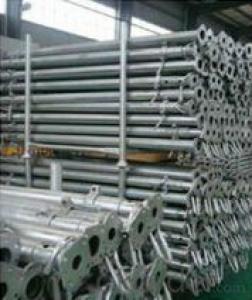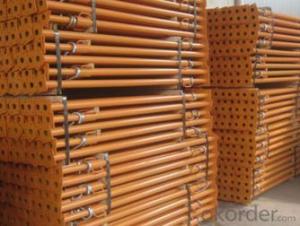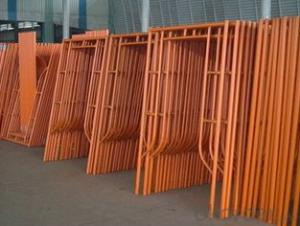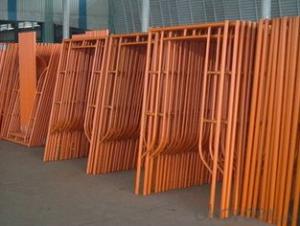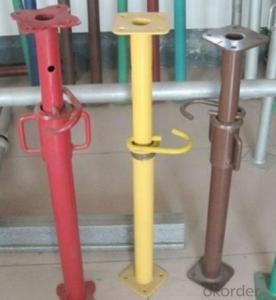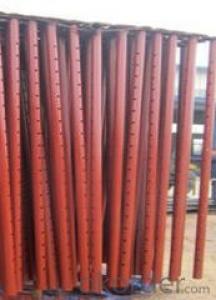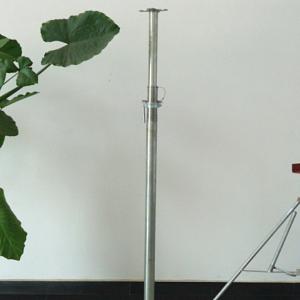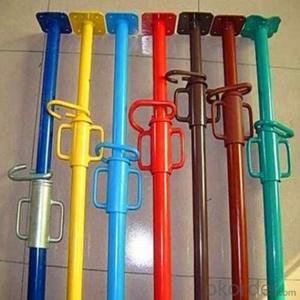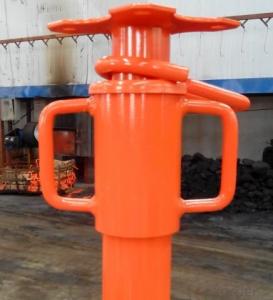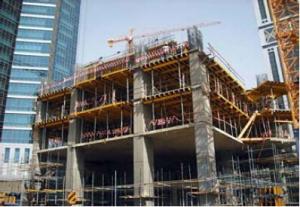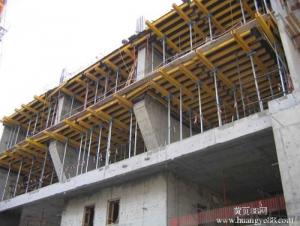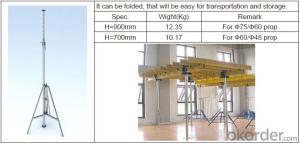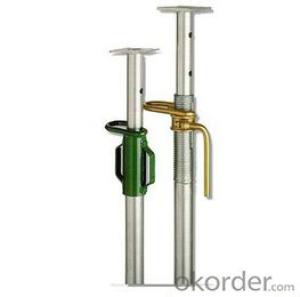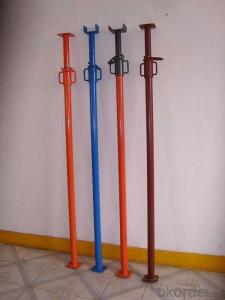Adjustable Galvanized Steel Prop scaffolding
- Loading Port:
- Tianjin
- Payment Terms:
- TT OR LC
- Min Order Qty:
- 10000 PCS
- Supply Capability:
- 10000 PCS/month
OKorder Service Pledge
OKorder Financial Service
You Might Also Like
Quick Details
| Model Number: | SP47.5-59.5 Steel Prop,SP47.5-59.5 Prop | ||||
| Material: | Q235 | Color: | dark red, green, blue or as you required | Surface treatment: | painted, powder coated, galvanized |
| Certification: | BV & SGS | Length: | 1.8-3.2m; 2.0-3.5m; 2.2-3.9m | Thickness: | 1.8/2.0/2.2/2.5/3.0mm |
| Diameter: | 47.5 - 59.5mm |
Packaging & Delivery
| Packaging Detail: | 1. Steel Prop is packed in bundle and wrapped with iron bar. 2. Usually, one 20 GP container can load around 1500-2100pieces of props. |
| Delivery Detail: | 10-20 days after deposit |
Specifications
1.Steel prop
2.High quality & high quality
3.Heavy duty
4.Painted or pre-galvanized
5.It used widely
Abstract
Application: support equipment in construction, mining, tunnel, bridge.
Description
1.An adjustable steel prop consists of internal tube, external tube, prop nut, base
plate and top plate.
2. Adjustable steel prop can be adjusted to any length within its range which is
convenient for using.
3.With its simple structure, adjustable steel prop is easy to assemble and dismantle
which can help to save your time, energy,and cost.
4.We have several kinds of adjustable steel prop which are Middle East type adjustable
steel prop, Spanish adjustable steel prop and Italian type adjustable steel prop.
- Q: Can steel props be used in the construction of airports or runways?
- Steel props, also referred to as steel shoring, find frequent application as temporary support structures in construction projects, including airports or runways. Their primary function is to provide stability and strength, ensuring the safety of workers and the structural integrity of the ongoing construction. When constructing airports or runways, these steel props prove useful in supporting concrete slabs, beams, or other structural components. They also serve as temporary support during repairs or maintenance work on existing airport infrastructure. With their adjustable height, high load-bearing capacity, and easy installation, steel props offer flexibility and make them a suitable choice for construction projects in airports or runways.
- Q: Are steel props adjustable for supporting inclined surfaces?
- Yes, steel props are adjustable for supporting inclined surfaces. Steel props, also known as adjustable steel props or steel acrow props, are versatile and can be extended or retracted to the desired height. This adjustability allows for the props to be used on inclined surfaces by adapting their length accordingly. By adjusting the length of the props, they can be securely placed on inclined surfaces to provide support and stability. Additionally, the props often come with adjustable heads that can be tilted to match the angle of the inclined surface, further enhancing their suitability for supporting such surfaces.
- Q: How do you ensure proper coordination between different trades when using steel props?
- Proper coordination between different trades when using steel props can be ensured through effective communication, regular meetings, and detailed planning. This includes sharing project schedules, specifications, and drawings with all relevant trades to ensure a clear understanding of their respective responsibilities and timelines. Additionally, having a designated project manager or coordinator who oversees the activities of different trades and facilitates communication among them can greatly enhance coordination. Regular site inspections and collaborative problem-solving sessions can also help identify and resolve any potential conflicts or issues that may arise during the construction process.
- Q: What is the average cost of a steel prop?
- There are multiple factors that influence the average price of a steel prop, including its size, quality, and brand. Currently, in the market, the cost per unit of a steel prop ranges from $30 to $100. It is crucial to consider that prices may vary depending on the region and suppliers you approach. Moreover, if you make bulk purchases or opt for rental options, there might be opportunities for discounts or reduced costs per unit. Hence, conducting thorough research and comparing prices from different sources is highly recommended to ascertain the precise average cost of a steel prop that aligns with your specific requirements.
- Q: How do steel props compare to trench jacks in terms of performance?
- Steel props and trench jacks serve similar purposes in providing temporary support to trenches or other structures. However, steel props generally offer better performance compared to trench jacks due to their adjustable height and load-bearing capacity. Steel props can easily be adjusted to different heights, allowing for better flexibility and adaptability in various construction scenarios. Additionally, steel props are typically designed to support heavier loads, making them more suitable for demanding construction projects. Overall, steel props offer improved performance and versatility compared to trench jacks.
- Q: How do you ensure proper bracing of steel props in high wind conditions?
- To ensure proper bracing of steel props in high wind conditions, there are several important steps that need to be taken. Firstly, it is crucial to conduct a thorough site assessment and analysis to determine the wind load and pressure that the steel props will be subjected to. This includes considering factors such as the height and size of the props, the location and surrounding environment, and any specific local wind codes or regulations. Once the wind load is determined, the next step is to design and implement an appropriate bracing system. This system should be specifically engineered to withstand the predicted wind forces and prevent any structural failure or collapse. One common method for bracing steel props in high wind conditions is to use diagonal bracing. This involves connecting the props to the surrounding structure or foundation using diagonally placed steel beams or cables. These diagonal braces help distribute the wind forces more evenly and provide additional stability and rigidity to the props. It is also essential to ensure that the bracing system is securely fastened and properly tightened. Loose or inadequate connections can compromise the effectiveness of the bracing and increase the risk of failure. Regular inspections and maintenance should be carried out to identify any loose or damaged bracing components and promptly address them. Furthermore, it is crucial to follow industry best practices and guidelines when it comes to bracing steel props in high wind conditions. This includes consulting with structural engineers, adhering to the manufacturer's recommendations, and complying with relevant building codes and standards. Finally, it is important to monitor weather conditions and be prepared to take necessary precautions in the event of severe weather or extreme wind conditions. This includes having an emergency plan in place and implementing additional measures, such as temporary windbreaks or additional bracing, if needed. In summary, ensuring proper bracing of steel props in high wind conditions requires a comprehensive approach that includes site analysis, design of an appropriate bracing system, secure fastening, adherence to industry best practices, and monitoring of weather conditions. By following these steps, the risk of structural failure or collapse can be significantly reduced, ensuring the safety and stability of the steel props.
- Q: How do you ensure proper alignment when using multiple steel props?
- To ensure proper alignment when using multiple steel props, there are a few key steps you can take: 1. Start by properly measuring and marking the positions where the steel props will be placed. This will help you maintain a consistent distance between the props and ensure they are aligned correctly. 2. Before installing the steel props, make sure the ground or foundation where they will be placed is level and stable. Any unevenness or instability in the ground can cause misalignment of the props. 3. When inserting the props, ensure they are fully extended and locked in position. This will prevent any movement or displacement once the load is applied. 4. Use a spirit level or laser level to check the vertical alignment of the props. This will help you ensure that they are perfectly upright and not leaning in any direction. 5. If you are working with multiple props in parallel, use string lines or laser levels to check the horizontal alignment. This will help you maintain a straight line and avoid any sagging or bending. 6. Regularly inspect the props during the construction process to ensure they are still properly aligned. Over time, the load or other factors may cause slight shifts or movements, so it is important to constantly monitor and readjust as needed. By following these steps, you can ensure that multiple steel props are properly aligned, providing the necessary support and stability for your construction project.
- Q: How to distinguish between the columns of single and double steel support
- The post section is consistent with the single column brace.The upper and lower sections of the column are not consistent, and the lower column is supported.
- Q: Are steel props adjustable from both ends?
- Indeed, both ends of steel props can be adjusted. Steel props, which are also referred to as steel shore or steel acrow prop, find extensive application in the construction field for the purpose of supporting and stabilizing diverse structures. These props are composed of a steel tube equipped with an adjustable mechanism at each end. By rotating the threaded rod or handle, the length of the prop can be extended or reduced to the desired elevation. This adaptable characteristic facilitates effortless installation and precise placement, thus rendering steel props a versatile and effective instrument in construction endeavors.
- Q: Can steel props be used for supporting temporary sound and lighting equipment?
- Yes, steel props can be used for supporting temporary sound and lighting equipment. Steel props, also known as adjustable steel props or acrow props, are commonly used in construction to support temporary structures, such as scaffolding, formwork, and falsework. They are designed to provide vertical support and can be adjusted to different heights, making them versatile and suitable for various applications. When it comes to supporting temporary sound and lighting equipment, steel props can be an ideal choice. They offer stability and strength, ensuring that the equipment is securely held in place. Additionally, steel props have a high load-bearing capacity, allowing them to support heavy equipment without any risk of collapse or instability. Furthermore, steel props are easy to set up and adjust, making them convenient for temporary installations. They can be quickly assembled and can accommodate different heights and configurations, allowing for flexibility in positioning the sound and lighting equipment as required. It is important to note that while steel props are suitable for supporting temporary sound and lighting equipment, proper planning and assessment of the load-bearing requirements should be carried out. The weight of the equipment and the height at which it will be positioned should be considered to ensure that the steel props used are of the appropriate size and strength. In summary, steel props can be effectively used for supporting temporary sound and lighting equipment. Their strength, stability, adjustability, and ease of setup make them a reliable choice for securely holding such equipment in place.
Send your message to us
Adjustable Galvanized Steel Prop scaffolding
- Loading Port:
- Tianjin
- Payment Terms:
- TT OR LC
- Min Order Qty:
- 10000 PCS
- Supply Capability:
- 10000 PCS/month
OKorder Service Pledge
OKorder Financial Service
Similar products
Hot products
Hot Searches
Related keywords
